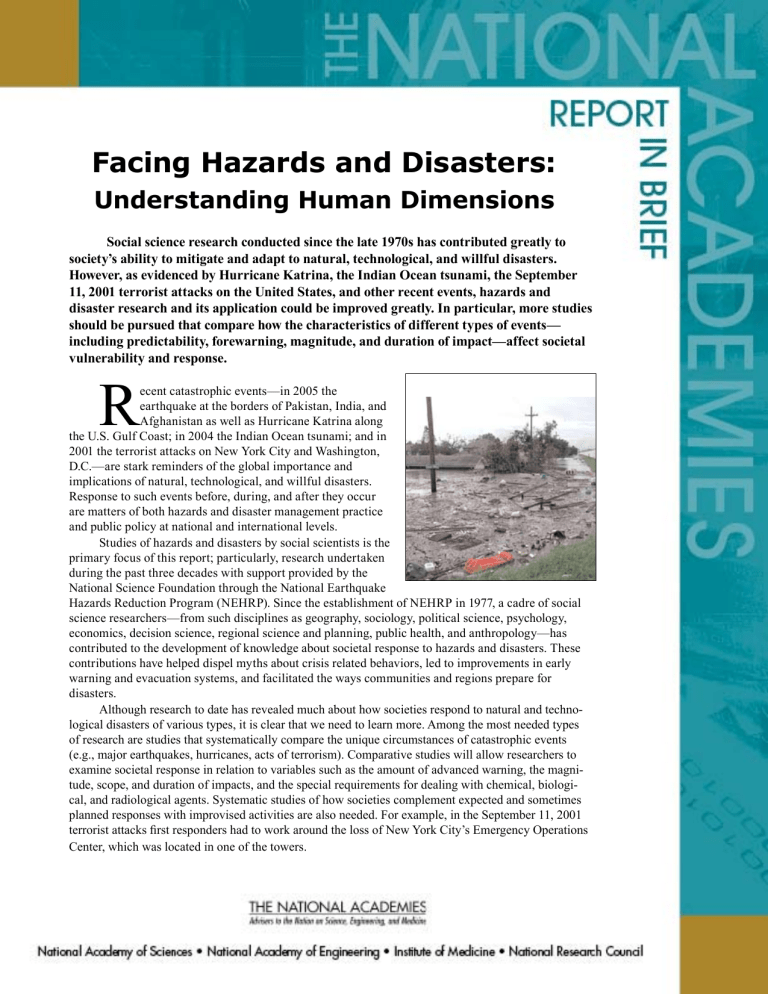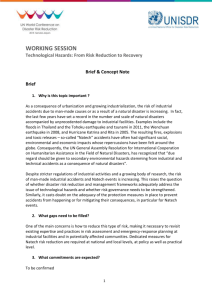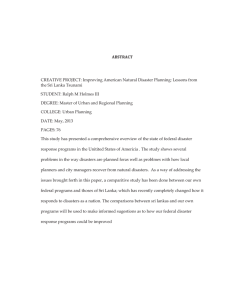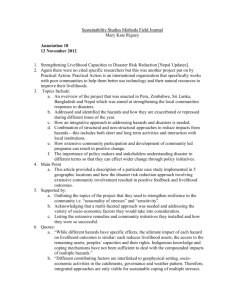Facing Hazards and Disasters: Understanding Human Dimensions

Facing Hazards and Disasters:
Understanding Human Dimensions
Social science research conducted since the late 1970s has contributed greatly to society’s ability to mitigate and adapt to natural, technological, and willful disasters.
However, as evidenced by Hurricane Katrina, the Indian Ocean tsunami, the September
11, 2001 terrorist attacks on the United States, and other recent events, hazards and disaster research and its application could be improved greatly. In particular, more studies should be pursued that compare how the characteristics of different types of events— including predictability, forewarning, magnitude, and duration of impact—affect societal vulnerability and response.
R ecent catastrophic events—in 2005 the earthquake at the borders of Pakistan, India, and
Afghanistan as well as Hurricane Katrina along the U.S. Gulf Coast; in 2004 the Indian Ocean tsunami; and in
2001 the terrorist attacks on New York City and Washington,
D.C.—are stark reminders of the global importance and implications of natural, technological, and willful disasters.
Response to such events before, during, and after they occur are matters of both hazards and disaster management practice and public policy at national and international levels.
Studies of hazards and disasters by social scientists is the primary focus of this report; particularly, research undertaken during the past three decades with support provided by the
National Science Foundation through the National Earthquake
Hazards Reduction Program (NEHRP). Since the establishment of NEHRP in 1977, a cadre of social science researchers—from such disciplines as geography, sociology, political science, psychology, economics, decision science, regional science and planning, public health, and anthropology—has contributed to the development of knowledge about societal response to hazards and disasters. These contributions have helped dispel myths about crisis related behaviors, led to improvements in early warning and evacuation systems, and facilitated the ways communities and regions prepare for disasters.
Although research to date has revealed much about how societies respond to natural and technological disasters of various types, it is clear that we need to learn more. Among the most needed types of research are studies that systematically compare the unique circumstances of catastrophic events
(e.g., major earthquakes, hurricanes, acts of terrorism). Comparative studies will allow researchers to examine societal response in relation to variables such as the amount of advanced warning, the magnitude, scope, and duration of impacts, and the special requirements for dealing with chemical, biological, and radiological agents. Systematic studies of how societies complement expected and sometimes planned responses with improvised activities are also needed. For example, in the September 11, 2001 terrorist attacks first responders had to work around the loss of New York City’s Emergency Operations
Center, which was located in one of the towers.
Current State of Social Science Research
The report’s assessment of the current state of social science research is based on a detailed review of scientific literature in the field. The report’s authoring committee also benefited from presentations and discussions that took place during two workshops held in conjunction with committee meetings, one in
Washington, DC and the other in Irvine, California.
Participants in the first workshop included researchers from the multidisciplinary hazards and disaster research community, practitioners, and representatives from various agencies. All participants in the second workshop were practitioners. Based on this input, the report draws the following conclusions about the current state of social science research:
1. Social science hazards and disaster research has advanced in the United States and internationally.
Under NEHRP social science knowledge has expanded greatly with respect to exposure and vulnerability
(physical and social) to natural hazards in the United
States, such that the foundation has been established for developing more precise loss estimation models and related decision support tools for hazards and disasters generally. The contribution of NEHRP to social science knowledge on natural hazards is less developed internationally as is its contribution nationally and internationally on exposure and vulnerability to technological and willful threats.
2. Social science knowledge about the responses of
U.S. households to natural hazards and disasters is well-developed.
There is a solid knowledge base at the household level of analysis on vulnerability assessment, risk communication, evacuation and other forms of protective action, and expedient disaster mitigation activities—for example, how people in earthquake or flood prone regions communicate about risks and warning messages, and how they respond to warning messages. The knowledge base and related explanatory modeling under NEHRP are skewed toward natural hazards (most notably earthquakes) as opposed to technological and willful hazards, and so far they have been confined primarily to national rather than international contexts.
3. Far less is known about how the characteristics of different types of hazards affect disaster preparedness and response. There has been little systematic comparative work on the special characteristics of natural, technological, and willful disasters (e.g., predictability and controllability; length of forewarning, magnitude, scope, and duration of impact) and their relationships with physical and social impacts. For example, how does the variation in warning time—little or no warning for an earthquake, short-term warning for tornados, longer-term warnings for hurricanes, and indeterminate warnings for terrorist attacks—affect preparedness and response? Greater understanding of event/impact relationships would directly facilitate the adoption of more effective disaster preparedness and mitigation practices.
4. More is known about immediate post-disaster responses of groups, organizations, and social networks than about mitigation or disaster recovery policies and practices.
While less so than the post-World War II studies that preceded NEHRP’s establishment in 1977, NEHRP-sponsored social science research has still tended to focus more on the immediate aftermath of disasters (post-disaster responses) and related emergency preparedness practices than on the affects of pre-disaster mitigation policies and practices, disaster recovery preparedness or longer term recovery from specific events. Research over several decades has contradicted myths that during disasters panic will be widespread, that large percentages of those who are expected to respond will simply abandon disaster roles, that local institutions will break down, that crime and other forms of anti-social behavior will be rampant, and that psychological impairment of victims and first responders will be a major problem. The
Figure 1: Disaster research, which has focused historically on emergency response and recovery, is incomplete without the simultaneous study of the societal hazards and risks associated with disasters, which includes data on the vulnerability of people living in hazard-prone areas. Historically, hazards and disaster research have evolved in parallel, with the former focusing primarily on hazards vulnerability and mitigation, the latter primarily on disaster response and recovery, and the two veins intersecting most directly with common concerns about disaster preparedness. However, it is vital that future social science research treat hazards and disaster research interchangeably and view the above five core topics within a single overarching framework.
more interesting and important research questions have become how and why communities, regions, and societies leverage expected and improvised post-impact responses in coping with the circumstances of disasters.
While much of organizational response to disaster is expected and sometimes planned, improvisation is an absolutely essential complement of predetermined activities.
5. The circumstances of terrorist threats could alter societal response to disasters. The possibility exists that some future homeland security emergencies could engender responses that are different from those observed in previous post-disaster investigations of natural and technological disasters. Particular attention is being given post-September 11, 2001 to vulnerability assessment of national energy, transportation, and information systems, terrorist threat detection and interdiction, the special requirements of nuclear, biological, and chemical agents, and the organizational requirements of developing multi-governmental preparedness and response systems. Fortunately these concerns are readily subsumed within the historically mainstream topics of hazards and disaster research depicted in Figure 1 above.
6. NEHRP has made important contributions to understanding longer-term disaster recovery.
Prior to NEHRP relatively little was known about disaster recovery processes and outcomes at different levels of analysis (e.g., households, neighborhoods, firms, communities, and regions). While research on disaster recovery remains somewhat underdeveloped, NEHRP funded projects have refined general conceptions of disaster recovery, made important contributions in understanding the recovery of households (primarily) and firms (more recently), and contributed to the development of statistically based community and regional models of post-disaster losses and recovery processes. Moreover, interest in the relationship between disaster recovery and sustainable development has become sufficiently pronounced in this field that the committee has allocated an entire chapter of the report to its consideration.
7. The management and accessibility of data needs immediate attention. Thus far social scientists have not confronted systematically issues related to the management and accessibility of data—from its original collection and analysis, to its longer-term storage and maintenance, and to ensuring its accessibility over time to multiple users. What the committee has termed the
“hazards and disaster research informatics problem” is not unique to this research specialty, or to the social sciences, natural sciences, and engineering generally.
But the informatics problem demands immediate attention and resolution as a foundation for future research and application of findings.
8. How research is communicated and applied is not well understood. More systematic research is needed on how hazards and disaster information generated by the social sciences and other disciplines is disseminated and applied. Such research will provide clearer understanding of what can be done within hazards and disaster research to further the dissemination of knowledge, thereby advancing sound mitigation, preparedness, response, and recovery practices.
9. A more diverse, interdisciplinary, and technologically sophisticated social science workforce is needed in the future.
Given the national and international importance of natural, technological, and willful disasters, the next generation of social scientists studying these events should become larger, more diverse, and more conversant with interdisciplinary perspectives and state-of-the-art research methods and technologies than the previous generation.
Recommended Improvements to Hazards and Disaster Research
Grounded in the above conclusions, the report offers 38 separate recommendations for improving how hazards and disasters research in the social sciences is conducted and used to inform policy and decision making. The recommendations, the majority of which relate to the need for comparative studies of societal responses to natural, technological and willful hazards and disasters, are encapsulated in the following three summary recommendations.
Summary Recommendation 1: Comparative research should be conducted to refine and measure core components of societal vulnerability and resilience to hazards of all types, to address the special requirements of confronting disasters caused by terrorist acts, and to advancing knowledge about mitigation, preparedness, response, and recovery related to disasters having catastrophic physical and social impacts.
The recommended comparative research is essential for isolating common from unique aspects of societal response to natural, technological, and willful hazards and disasters. A key contribution of NSF through NEHRP over the years has been that, while necessarily emphasizing earthquakes, since its inception the program has encouraged and supported comparisons of societal responses to earthquakes with other natural as well as technological hazards and even with terroristinduced events, though less so. This historical emphasis within NEHRP dictates that a rigorous approach should prevail in making generalizations to terrorism and that there is a continuing need for systematic comparisons of all societal hazards and disasters using the conceptual and methodological tools summarized in this report. A comparative perspective should be sustained within NSF and also prevail in the new DHS.
Summary Recommendation 2: Strategic planning and institution building are needed to address issues related to the management and sharing of data on hazards and disasters (hazards and disaster informatics), sustain the momentum of interdisciplinary research, advance the utilization of social science findings, and sustain the hazards and disaster research workforce.
Of particular importance because of its direct relationship to Summary Recommendation 1 is the call for strategic planning to address issues of data management and data sharing. A Panel on Hazards and Disaster Informatics should be created to guide these efforts. The Panel should be interdisciplinary and include social scientists and engineers from hazards and disaster research as well as experts on informatics issues from cognitive science, computational science, and applied science. The
Panel’s mission should be, first, to assess problems of data standardization, data management and archiving, and data sharing as they relate to natural, technological, and willful hazards and disasters, and second, to develop a formal plan for resolving these problems to every extent possible within the next five years.
Summary Recommendation 3: NSF and DHS should jointly support the comparative research, strategic planning, and institution building called for in Summary Recommendations 1-2.
The proposed leveraging of NSF with DHS support is critical because these two agencies are focal points of federal funding for research on all types of extreme events. The two agencies should take advantage of opportunities to leverage their resources by jointly funding social science hazards and disaster research whenever possible. This could lead to a better understanding of the similarities and differences between natural, technological, and human-induced hazards and disasters. It could also provide the foundation for sound science-based decision making by policy makers and practitioners, whether they are developing measures to counter a major natural disaster like Hurricane Katrina or a terrorist-induced event like the September 11th attacks on the World Trade Center and Pentagon.
Social science research on the September 11, 2001 terrorist attacks as well as more limited observations that have been made thus far on Hurricane Katrina indicate, first, that many previous findings about societal response to hazards and disasters remain valid, and second, that there is still much to be learned about responses to truly catastrophic events.
A Vision of Social Science Contributions to Knowledge and a Safer World
Considerable progress has been made during the past several decades by social scientists studying different types of hazards and disasters, sometimes working collaboratively with investigators from other disciplines. However, the continuing challenge for the social sciences centers on unraveling the complexity of individual and collective action before, during, and after disasters occur; on providing research findings that improve loss reduction decision-making; and on assessing hazards and disaster related policies and programs. The major opportunity for the social sciences is to employ state-of-the-art theories, methods, and supporting technologies to further this type of knowledge development, which can in turn further science-based decision making by policy makers and practitioners. The responsibility for attaining the report’s vision for hazards and disaster research is by no means the sole responsibility of the
National Science Foundation. That responsibility can and should be shared with the entire hazards and disaster research community, with those who fund hazards and disaster studies, and certainly with those who stand to learn from these studies.
Committee on Disaster Research in the Social Sciences: Future Challenges and Opportunities:
Gary Kreps, (Chair), The College of William and Mary; Philip R. Berke, The University of North Carolina at Chapel
Hill; Thomas A. Birkland, University at Albany, State University of New York; Stephanie E. Chang, University of British
Columbia; Susan L. Cutter, University of South Carolina , Michael K. Lindell, Texas A&M University; Robert A. Olson,
Robert Olson Associates, Inc.; Juan M. Ortiz, Tarrant County, Texas Office of Emergency Management; Kimberly
Shoaf, University of California, Los Angeles; John H. Sorensen, Oak Ridge National Laboratory; Kathleen Tierney,
University of Colorado at Boulder; William A. Wallace, Rensselaer Polytechnic Institute; Anthony M. Yezer, George
Washington University; William A. Anderson, ( Study Director ), National Research Council; Byron Mason , (Program
Associate), National Research Council; and Patricia Jones Kershaw (Senior Program Associate until December 2004).
This report brief was prepared by the National Research Council based on the committee’s report.
For more information, contact the Division on Earth and Life Studies at (202) 334-3362 or visit http://dels.
nas.edu/. Facing Hazards and Disasters: Understanding Human Dimensions will be available from the
National Academies Press, 500 Fifth Street, NW, Washington, D.C. 20001; (800) 624-6242; www.nap.edu.
© 2006 The National Academy of Sciences



